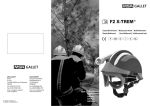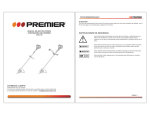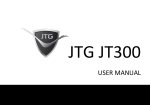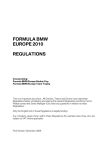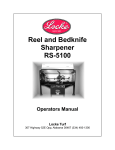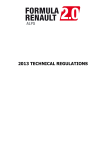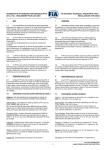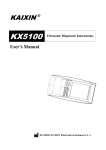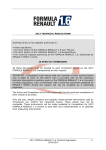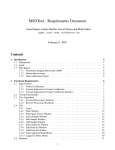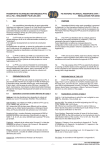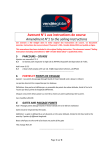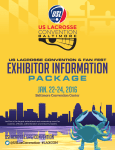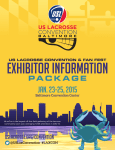Download DAMC BAMBINO TRIALS 2012-13
Transcript
DAMC BAMBINO TRIALS 2012-13 Organised by DUBAI AUTODROME MOTORSPORTS CLUB SERIES REGULATIONS REGULATIONS The final text of these Sporting Regulations shall be the English version, which will be used should any dispute arise as to their interpretation. Headings in this document are for ease of reference only and do not form part of the regulations. 1 – GENERAL SERIES INFORMATION The ‘Bambino Trail days’ and potential series and its events shall be run in accordance with the requirements of Dubai Autodrome Motorsport Club (DAMC). The ‘DAMC’ Bambino Trails/Series” will consist of two rounds initailly, running at Dubai Kartdrome Outdoor Circuit. DAMC will start off by holding two round on the dates mentioned below, and if popular DAMC may take the decision to release further dates for races which would then enable and permit the inclusion of Series Points scoring - 2.7 2 – INFORMATION SPECIFIC TO THE SERIES 2.1 ORGANISER: Dubai Autodrome Motorsports Club (DAMC) Dubai Kartdrome, P.O. Box 57331 Dubai U.A.E Phone: +971 (0) 4 4361320 Fax: +971 (0) 4 3678750 E-mail: [email protected] Web: www.dubaiautodrome.com 2.2 - DATES / EVENTS: ROUND 1 SATURDAY 10th of November ROUND 2 SATURDAY 24th of November ROUND 3 TBC ROUND 4 TBC ROUND 5 TBC ROUND 6 TBC 2.3 - PROVISIONAL INFORMATION OF THE MEETING: Additional information will be available in the Supplementary Regulations for each meeting. A detailed time schedule for each event will be issued in advance and displayed on the official notice Board. Copies will also be available at the circuit upon arrival. 2.4 - ENTRIES: 2.4.1 - Reception Office: Dubai Autodrome Motorsports Club (DAMC) P.O. Box: 57331 Dubai, U.A.E Phone: +971 (0) 4 4361320 Fax: +971 (0) 4 3678750 E-mail: [email protected] 2.4.2 – Dates/Times: The Organisers reserve the right to refuse entries submitted after this deadline. 2.4.3 - Receipt: Any entry not accompanied by the fee shall be null and void. 2.4.4 - Restriction: Maximum Entries apply in all classes. Entry will be accepted in the order of receipt of the entries. There will be a maximum limit of 10 karts. The organizer has the right to increase or decrease the maximum entry limit of karts at anytime. 2.4.5 - Fees: No joining fee or membership is required. Race Entry Fee: AED 250 * Transponder hire will be charged at AED 200 per day and transponders will be distributed at signing on as per article 4.3, 4.3.1 2.4.6. – Payments: Payments should be made in line with the following methods: Cash – In person at the circuit Credit Card – Only in person at the circuit or faxing back credit card booking forms that can be requested from email [email protected]. Please note that credit card payments cannot be accepted by telephone, even as security. Online Payments - are available through our website. To request the link, please call Rowena on 04 4361320 or email [email protected] 2.5 – LICENCE AND AGE REQUIREMENTS: Drivers do not require a competition licence to take part in the Series. However, participants must have basic track knowledge and be conversant with circuit rules including flag signals. As such, all drivers must successfully complete a driving assessment and basic written/oral test at Dubai Kartdrome Circuit before being allowed to take part in the series. This must be arranged in advance with the circuit. Drivers must be at least 5 years of age to compete in the series. An original passport must be provided as authentication. The maximum age is 8 years. 2.6 – RACE MEETING FORMAT: *DAMC reserves the right to change the format. Each race meeting will consist of: - Signing on - Scrutineering - Driver’s Briefing - Practice - Time Trial 1 - Time Trial 2 - Time Trial 3 - Award presentation 2.6.1 – Signing on: Signing on will commence at the time stipulated in the Event Schedule. Each driver is required to complete and sign a registration form (this must be done at each visit). Any driver not signing in during the allocated registration window will not be permitted to race. Pushers must also sign on at this time with their respective driver (see Article 3.1). 2.6.2 – Scrutineering: Scrutineering will take place in a predetermined area and at the time specified in the event Supplementary Regulations. Drivers must present themselves along with their race wear and kart (which must be ready to race) to the Scrutineers at the allotted time for a basic safety and technical compliance inspection. Drivers who do not successfully pass Scrutineering will not be permitted to take part in the race meeting. 2.6.3 – Driver’s Briefing: The Official Driver’s Briefing, mandatory for all drivers and pushers, will take place at the time stipulated in the schedule. Any driver who is absent or has not got their Parent, Legal Guardian or the Adult over the age of 18 who Signed them on, present with them, will gain a penalty and may be prevented from racing altogether, with no refund. This is without exception. Any new drivers racing at the venue for the first time (regardless of experience) must attend a further briefing which will cover circuit rules and procedures in more detail. This will normally follow the Official Driver’s Briefing. 2.6.4 – Practice: The length of this session will be stipulated in the Race Schedule attached to the Event Supplementary Regulations. The warm up session is mandatory. Failure to participate in this session may result in exclusion from the remainder of the meeting. 2.6.5 – Time Trials: The length of each session will be stipulated in the event Supplementary Regulations or on the timetable. All karts are released one-by-one from the Pre-Grid at regular intervals. Lap times are recorded and points are awarded in terms of best lap time classification (see 2.6.6). 2.6.6 – Award Presentation: Awards will be awarded to the top drivers in class, according to the overall best lap time of the day set in either of the three Time Trial sessions. All participants completing the race day will receive a Certificate of Accomplishment. Everyone is encouraged to stay for the presentation. All drivers are to ensure that race suits are worn and zipped up with collar closed. Race footwear should also be worn. 2.7 – POINT SCORING: 2.7.1 – Overall Score: Series points are awarded for each Time Trial in terms of best lap time classification. For each Time Trial, the driver recording the fastest lap time will be awarded a maximum of 20 points. Points are scored per Time Trial as follows: Fastest Lap 20 points 2nd Fastest Lap 19 points 3rd Fastest Lap 18points and so on down to 20th place. 20th place and any competitor thereafter will receive 1 series point. In the case of 2 drivers achieving identical best lap times, the organisers will revert to the second best lap time set by each individual in order to determine the final classification. In case a Time Trial is cancelled because of “force majeure,” no points will be awarded. In the case that 2 or more drivers finish the Bambino Series with the same number of points, the higher placing will be awarded to the driver with the greatest number of fastest Time Trial laps. If this number is equal then the greatest number of 2nd fastest Time Trial laps will be used, and so on until a winner emerges. If this procedure fails to produce a result, DAMC Committee will nominate a winner according to such criteria as it deems fit. Bonus points will be awarded for various achievements (see article 2.7.3) while penalty points will be deducted for driving infringements (see article 2.7.4) The Race Day winners are determined by the drivers who set the fastest lap times on the day. DAMC will award prizes to the top 3 fastest drivers. Points awarded from the 3 time trials on the day, maybe be calculated towards the total Championship Series which may be held over the 2012/2013 season only if DAMC chooses to continue (see 1) 2.7.2 – Did Not Start (DNS): DNS is used to classify any driver who fails to cross the start line at any point during a Time Trial. This number of points awarded for a DNS is 1 less than the last classified competitor. 2.7.3 – Bonus Points: Extra Bambino Series points are available as follows: 5 “Series Support” bonus points will be awarded to each driver entering and competing at each round. [Drivers must compete in at least 4 Rounds in order to receive support points.] 2.7.4 – Penalty Points: Drivers who receive a black flag will receive a penalty in accordance with the nature of the offence, at the discretion of the Race Director. The following non-exhaustive guide covers a number of common infringements and their Associated penalties: Loss of control (spinning or leaving track) -1 point Contact (with another competitor) -2 points Causing a collision -3 points Pit Lane Speeding -3 points Ignoring flag signals -3 points Careless Driving (general) -3 points Abusive behaviour (including parents) -10 points These are for guidance purposes only. The Organisers reserve the right to inflict greater penalties, financial or otherwise, (including exclusion, suspension and disqualification) if the behaviour of a driver (or their support crew) contravenes the standards advocated by and associated with the Series and its supporters and sponsors. Any decision made by the Clerk of the Course is final and there will be no scope for appeal. Any driver with a genuine grievance should request to see the Clerk of the Course as soon as possible after the session. 3 – ADDITIONAL RULES/PROCEDURES 3.1 – PUSHERS: Each driver must have a ‘pusher’ representing them. Pushers must register with their respective driver at Signing On (see Article 2.6.1) where they will receive a high-visibility vest. Pushers must be at least 18 years of age and must attend the Driver’s Briefing with their driver where instructions pertaining to the Race Day will be given. During Bambino sessions, pushers will be stationed intermittently around the circuit (on safe zones) at the behest of the Clerk of the Course. It is the responsibility of each pusher to provide timely assistance to all Bambino drivers as and when needed. 3.2 – PRE-GRID: At the allotted time, drivers and pushers will make their way to the Pre-Grid in preparation for the Practice or Time Trial session. Drivers/karts will be lined up on the Pre-Grid in single file according to the order in which they arrive. Drivers will not be permitted to line up on the Pre-Grid without a pusher present. It is forbidden to carry out any work and/or set-up on the kart on the Pre-Grid. When ready the Clerk of the Course will allow all Pushers to take up positions around the circuit. At the green flag signal, drivers will be released one-by-one from the Pre-Grid at appropriate intervals as dictated by the Pre-Grid Marshal. Drivers (or pushers) arriving after this time will only be permitted to join the circuit with the express permission of the Clerk of the Course. 3.3 – BREAKDOWNS: Drivers must remain inside their karts at all times. In the event that a kart gets stuck (on or off the circuit) or if a technical problem occurs which prevents the driver from reaching the Pit Lane, the driver should raise his/her hand and pull the kart over to a safe place, away from the racing line. The closest pusher will attend the scene at a safe moment to move the kart and driver to a safe place off the track. Once in a safe position the pusher may attempt to restart the kart or repair the problem. If this is successful the driver may rejoin the circuit when it is safe to do so. If the kart cannot be restarted, the Marshals will supervise the extraction of the driver to a place of safety with the assistance of the pusher(s). 3.4 – FINISHING PROCEDURES: The chequered flag signal will be given at the Start Line to indicate the end of the session (see Article 10). After having received the chequered flag all karts must proceed directly to the Pit Lane under yellow flag conditions, using the normal course of the track, without performing doughnuts, without stopping, without giving or receiving any object whatsoever and without any help (except that of Marshals if necessary). Any driver removing both hands from the steering wheel whilst travelling at considerable speed, whether in celebration or not, will be adjudged to be driving dangerously and subject to a penalty, at the discretion of the Clerk of the Course. 3.5 – PIT LANE SPEED: Pit Lane speed must be kept to walking pace at all times. This is an important safety rule that must be adhered to as the Pit Lane is the only area in which driven karts are mixed with unprotected drivers and Officials. Any driver deemed to be speeding in the Pit Lane by the Officials will receive a penalty at the discretion of the Clerk of the Course. 3.6 – PARC FERMÉ: The Chief Scrutineer may invoke Parc Fermé at his discretion which will be sufficiently secure so that no unauthorised person can gain access to it. Drivers are not permitted to leave Parc Fermé until expressly permitted by the Officials. 4 – ORGANISER’S SUPPLEMENTARY PROVISIONS 4.1 – TYRES: Only Mojo C2 tyres may be used (front 4.0 x 10.0–5; rear 5.0 x 11.0–5). Strictly no modifications or tyre treatments are allowed. 4.2 – FUEL: Petrol: unleaded commercial quality from petrol station, 95-98 octane. Oil: XPS Kart Tec 2-stroke oil or equivalent. Fuel/oil ratio should be 20:1. 4.3 – TRANSPONDER: 4.3.1 – Transponder Hire or Purchase: Transponder hire will be charged at AED 200 per day and transponders will be distributed at signing on. There are a limited number of transponders available for hire. These will be allocated as Entry Forms are received on a first-come, first-served basis. Any Entry received after all hire transponders are allocated will need to buy a transponder. Transponders are available for purchase at AED 1500 per unit. This includes charger, user manual and fixing kit. Please check in advance with the Series Organisers for availability. Onboard lap timers or devices of that which measure lap time and viewable by the driver, is forbidden to be used during time trials. 4.3.2 – Transponder Fitting: The transponder must be mounted in an approximately upright position and secured at a height of 25cm ±5cm (measured from the ground to any part of the transponder). It is the driver’s responsibility to ensure that the transponder is fitted in the correct position at all times when driving. Failure to do so may result in the transponder functioning intermittently or not functioning at all which, in turn, will lead to non-classification. 5 – TECHNICAL REGULATIONS 5.1 – GENERAL: The following regulations may be amended at any time by DAMC by way of Competitor Bulletins or Event Supplementary Regulations which will be posted on the Official Notice Board at each event. Karts are only allowed to race if they are in a condition which meets the Series safety standards and if they comply with the regulations. They must be maintained in such a way as to not represent a danger to the driver or other participants/spectators. ANYTHING WHICH IS NOT EXPRESSLY ALLOWED IS FORBIDDEN 5.2 – CHASSIS: Only chassis produced by a reputable chassis manufacturer will be allowed. Competitors unsure of whether a particular model fits in with this requirement should contact the Organisers for approval. Such chassis will be subject to the following criteria: Wheel base: 780mm (±20mm) Rear axle: 25mm solid or 30mm hollow Brake system must be mechanical type and work on rear wheels only Secondary brake cable must be fitted Chain guard must be fitted 5.3 – NUMBERS: Numbers must be clearly displayed on the front and back of the kart and on the outside face of both side pods. Numbers must be black and at least 15cm high with 2cm stroke on a yellow background. The range of numbers is 1 to 20. Number requests must be confirmed by the series Organisers and are issued on a first-come, first-served basis. 5.4 – WEIGHT: At the outset of the Bambino Series there is no minimum weight specified. However, the Organisers reserve the right to stipulate a class minimum at any time and will communicate such information to competitors through the Event Supplementary Regulations. Any ballast must be fitted safely and securely to either the floor tray or the seat by means of at least two mechanical fixings. No single piece should exceed 5kg. 5.5 – ENGINE: Engines to be used in the DAMC Bambino Series are the standard, unmodified Comer C50. These engines are unsealed but must always remain within the confines of the original Comer C50 engine fiche and must be used in standard condition as manufactured by Comer. Filing, grinding, polishing or lightening of any component is expressly forbidden. The addition of material or coatings to any component is not allowed. All components used in or on the engine must be of original Comer manufacture unless otherwise stated within these regulations. The fitting of helicoils and inserts to repair damaged threads is permitted, providing that such repairs are not used to derive any benefit other than rectification of damage. The head volume must be no less than 7cm3. It is recommended that the engine is checked at regular intervals to ensure that this is the case since carbon build-up in this area can reduce the volume. This is wholly the Entrant’s responsibility. 5.6 – ENGINE ANCILLARIES: 5.6.1 – Clutch: The clutch unit must remain standard with no machining or modification permitted. All clutch drums must feature the standard 10 tooth gear sprocket. 5.6.2 – Carburettor and Air Filter: The carburettor must be the standard, unmodified Dellorto SHA 14/12L with standard main jet size 58. The standard air filter must contain at least one standard foam air filter element and must be fitted as close to vertical as is reasonably practicable. An inline fuel filter (one which has been approved for karting use) can be fitted between the fuel tank and carburetor to prevent any foreign element blocking small passage ways. 5.6.3 – Exhaust: The exhaust must remain standard as defined by the engine fiche. The outlet holes must remain unmolested with no machining or filing permitted. 5.6.4 – Spark Plug: Only the standard Champion RC7JY or Bosch WS5F spark plugs are allowed. The sealing washer must be original and intact. 5.7 – GEARING: Gearing will be fixed provisionally at 85teeth. If the organizers deem it necessary to increase the rear sprocket size for following series rounds, this will be announced. 6 - SAFETY EQUIPMENT 6.1 – CRASH HELMET: Drivers must wear a helmet with efficient and unbreakable protection for the eyes and must fit well. Helmets must comply with Snell-FIA standards CMS2007 or CMR2007. 6.2 – RACE SUIT: Race suits are mandatory. It is strongly recommended that drivers wear kart race suits with a “Level 2” homologation granted by CIK-FIA. Drivers wishing to use race suits which do not meet this standard must present them to the Clerk of the Course for inspection and approval. 6.3 – GLOVES: Gloves are mandatory. They must be in good condition and must completely cover the hands and fingers. 6.4 – FOOTWEAR: Drivers MUST wear suitable flat-soled footwear. Sandals, high heels or open-toed footwear will not be permitted. It is strongly recommended that the footwear also provides ankle protection. Kart race boots are obviously ideal. 7 – GENERAL SAFETY A. It is strictly forbidden for drivers to drive their karts in a direction opposite to that of the race, unless this is strictly necessary to remove the kart from a dangerous situation. B. During each on-track session during the Event, drivers may use the track only and must at all times observe the dispositions of the CIK International Sporting Code relating to driving on circuits. The circuit is defined by the white lines on both sides of the track. Drivers are allowed to use the whole width of the track between these lines. If the four wheels of a kart are outside these lines, the kart is considered as having left the track. C. A speed limit of 5mph is imposed in the pit lane at all events. Any driver deemed to be exceeding this speed limit will be liable to sanctions provided for in the Regulations. D. No driver may leave the Parc Fermé Area without permission from the Chief Scrutineer. E. Any driver who intends to leave the track by means of the Pit Lane shall demonstrate his/her intention in due time and shall ensure that he/she does so safely. F. In each session of the Event, drivers must at all times wear the full equipment defined under Article 7 of these Regulations. G. It is forbidden to circulate with motorbikes, scooters or any other motorised devices in the Paddock. The driving of karts in the Paddock Area is forbidden under all circumstances H. In the unusual case of rain, slick tyres will continue to be used. Racing will continue as normal at the discretion of the Race Director or Clerk of the Course in collaboration with the Chairman of the Stewards. Normally, racing will only be halted if driving conditions become dangerous, e.g. in the case of standing water. It is assumed that drivers will be able to recognise wet conditions due to the appearance of rain drops on their visors. 8 – FLAG RULES Yellow Flag: This is a signal of danger to indicate a hazard which may be wholly/partly blocking the track or may be just off the track. Drivers must reduce speed, not overtake and be prepared to change direction (or even stop if necessary). Yellow flags will normally be shown only at the marshal post immediately preceding the hazard. Caution should be exercised (reduced speed with strictly no overtaking) from the first yellow flag until the incident has been safely negotiated. Red Flag: This flag is used to stop a practice session or Time Trial. Drivers must immediately slow down and proceed with great caution and without overtaking to the safety area. This exact location will vary from venue to venue and will be explained clearly by the Clerk of the Course in the Driver’s Briefing. Yellow and Red Striped Flag: This flag means slippery surface and will be shown to inform drivers that there is a deterioration of adhesion due to oil or water on the track in the area beyond the flag. Blue Flag: This flag is shown to a driver as an indication that he/she is about to be overtaken. Green Flag: This flag is used to indicate that the track is clear and is used to signal the start of a practice session or Time Trial. White flag: This flag is used to indicate to the Driver that there is a much slower vehicle on the sector of track controlled by that flag point. Black and White Chequered Flag: This flag signifies the end of a practice session or Time Trial and is give at the Start/Finish Line. Drivers must slow down and proceed carefully to the Pit Lane without overtaking. The following three flags will normally be shown at the Start Line and accompanied by a black board with a white number which refers to the kart whose number is displayed. These flags may also be displayed at places other than the Start Line should the Clerk of the Course deem this necessary. Black and White Flag Divided Diagonally: This flag should be shown only once and is a warning to the driver concerned that he has been reported for unsportsmanlike behavior. Black Flag: This flag is used to inform the driver concerned that he/she must return to the Pit Lane immediately and report to the Clerk of the Course. Black Flag with an Orange Disc: This flag is used to inform the driver concerned that his/her kart has mechanical problems likely to endanger him/her or others and he/she must return to the Pit Lane on the next lap.










